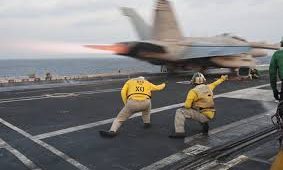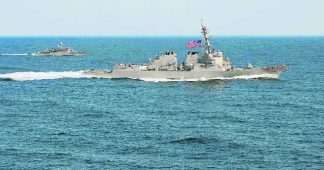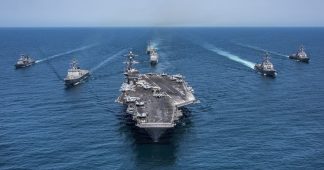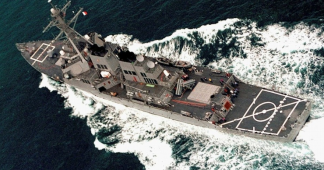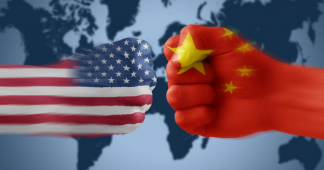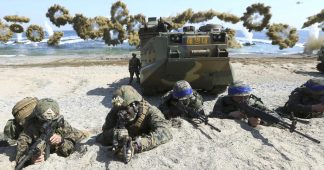By Peter Symonds
6 July 2020
In a naked and provocative display of military force, the US Navy is conducting war games in the strategic South China Sea involving two huge nuclear-powered aircraft carriers at the same time as Chinese naval exercises are taking place in the same region.
The USS Ronald Reagan and the USS Nimitz entered the South China Sea along with their strike groups that include guided-missile cruisers and guided-missile destroyers. More than 10,000 naval personnel were on aircraft carriers along with their complement of fixed-wing warplanes and helicopters.
Far from being routine, the war games involved “high-end integrated exercises” aimed at building “unmatched flexibility, endurance, maneuverability, and firepower in an all-domain warfighting environment.” In other words, the purpose was to test naval capabilities in a conflict with China involving both offensive operations using war planes and defending the ships from any Chinese counter-attack.
“We’re really operating at a higher tempo and simulating a higher end of combat power than we would typically do in a shorter length exercise,” Admiral George Wikoff, commander of the USS Ronald Reagan strike-force said. “We’re flying around the clock, hundreds of sorties a day in a 24-hour period.”
In a statement issued on July 4, Wikoff boasted that his strike group was celebrating Independence Day “with unmatched sea power” in the South China Sea. He declared that the two aircraft carrier strike groups formed the “most effective and agile fighting force in the world.”
The last operation was only the sixth time in the past two decades that the US Navy has conducted war games involving two aircraft carrier strike groups in the western Pacific. The exercises in the South China Sea were preceded by similar ones last week involving a third aircraft carrier—the USS Roosevelt—and its strike group in the neighbouring Philippine Sea.
The pretext for the naval exercises was to ensure “freedom of navigation”—the same excuse that has been used to justify escalating US naval provocations in the South China Sea. These include so-called “freedom of navigation” operations in which US warships deliberately intrude into territorial waters claimed by China around its islets in the area—threatening to trigger a clash.
In April, the US Navy carried out two such operations in as many days followed by another on May 7. On May 28, the guided-missile destroyer USS Mustin passed within the 12-nautical-mile territorial limit of Woody Island in the Paracel group that has been occupied by China for decades.
The US has also been seeking to involve its allies in war games in the South China Sea which have included live-fire drills with the Australian navy in April and manoeuvres with the Japanese navy in June. Washington has been seeking to establish the so-called Quad—a quasi-military alliance against China involving Australia, Japan and India.
A US Pacific Fleet spokesman absurdly claimed that the weekend’s operation was “not in response to any political or world events” and thus was not directed at China. However, the Pentagon issued a statement last week condemning Chinese naval exercises near the Chinese-administered Paracel Islands in the South China Sea which ran from July 1–5.
The US Defence Department branded the Chinese exercise as “the latest in a long string of PRC actions to assert unlawful maritime claims and disadvantage its Southeast Asian neighbors in the South China Sea.” The US vision, it stated, was for “a free and open Indo-Pacific region,” and was simply ensuring the sovereignty and rights of all nations in the region.
In reality, the US intervention in the South China Sea was a component of the Obama administration’s aggressive “pivot to Asia” aimed at undermining China diplomatically, economically and militarily. Hillary Clinton, as US secretary of state, transformed what had been low-level regional territorial disputes involving China and its neighbours into a dangerous flashpoint by declaring that the US had a “national interest” in the South China Sea.
For the US to declare China’s maritime claims as “unlawful” is completely hypocritical because Washington has never ratified the UN Convention on the Law of the Sea (UNCLOS). Not being a party to any of the territorial disputes, the US encouraged and backed the Philippines to challenge China’s claims in the UN Permanent Court of Arbitration which brought down a highly political decision in 2016 negating China’s longstanding historic claims in the South China Sea.
In reality, US naval operations in the South China Sea and other waters close to the Chinese mainland have nothing to do with defending China’s neighbours but are intimately connected to US preparations for war. The US strategy for conflict with China is based on launching massive air and missile attacks from warships and bases in the region combined with a naval blockade designed to starve China into submission. The South China Sea is adjacent to key Chinese submarine bases on Hainan Island in south-east China.
The US military exercises take place at the same time as the Trump administration has ratcheted up its confrontation with China across a range of sensitive issues. These include: blaming Beijing for the COVID-19 pandemic, imposing penalties over China’s new security law for Hong Kong, stirring up the border conflict between India and China, and imposing restrictions on the Chinese telecommunications giant Huawei.
Last Friday in an interview with MSNBC, White House trade adviser Peter Navarro launched into a venomous attack on Beijing declaring that it was responsible for the huge death toll from COVID-19. Without a shred of evidence, he suggested that China had “weaponized” the virus, declaring: “They hid the virus. They sent hundreds of thousands of Chinese nationals over here to seed and spread the virus before we knew.”
The Trump administration’s big lies are not only aimed at diverting public anger over its criminal handling of the pandemic outward against a foreign enemy. Navarro’s attack on China is part of the rapidly escalating preparations for economic war and military conflict that has been developing over the past decade. The “pivot to Asia” under Obama has been accelerated under Trump, in particular in the wake of the COVID-19 pandemic.
US imperialism regards China as the chief obstacle to maintaining its dominance in Asia and globally. The pandemic has graphically exposed the historic decline of the US to which the Trump administration is responding by stepping up its confrontation with China on all fronts.
